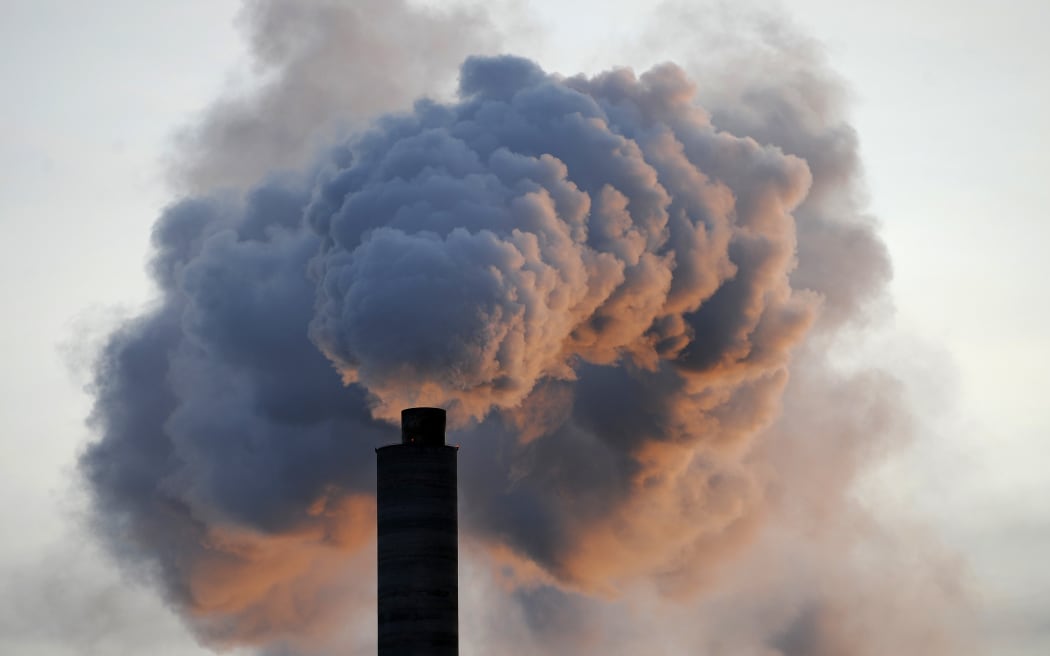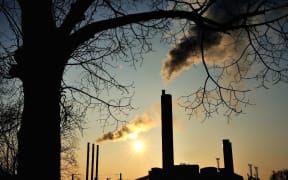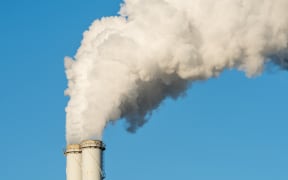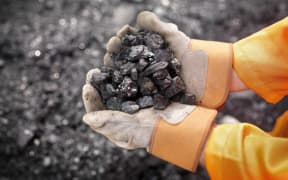
The Ministry for the Environment is asking how many tonnes of carbon dioxide the government should sell at auction from 2025-29. Photo: AFP
A new steel-making furnace will reduce emissions so much that environment officials have floated the idea of reducing the whole country's supply of carbon credits to compensate.
The Ministry for the Environment is asking the public - and emitters - how many tonnes of carbon dioxide the government should sell at auction from 2025-29, and at what range of prices.
When NZ Steel's new electric arc furnace starts working in around 2027, hundreds of thousands of tonnes worth of permits to pump out carbon dioxide that the old furnace would have needed to cover its coal use will be up for grabs.
These could be sold to other emitters, lowering pollution prices and lowering incentives for other companies to go cleaner, says the ministry.
The steel maker's emissions are covered by the Emissions Trading Scheme (ETS), the country's main tool for cutting planet-heating gases. It requires emitters to pay for every tonne of carbon dioxide they make.
The government auctions these permits-to-pollute four times a year, and the volume of tonnes for sale is set two years in advance, in line with what kind of reductions are needed to meet the country's climate targets. These targets require emissions to shrink every year, on the way to carbon neutral by 2050.
But the deal with Labour to help fund the furnace was not done when the auction volumes were set for 2025-29. The unexpected win could lead to more 'surplus' carbon credits being available in the carbon market than expected, at lower prices, lowering incentives for companies to cut greenhouse gases, according to the ministry's consultation document.
Why the 'steel deal' matters
NZ Steel's new furnace was partly funded by the Labour government under a programme to dish out grants for companies getting off coal and gas.
It was given as an example by the ministry as a move that was unexpected when the current auction volumes were set, one that on its own will slash the country's emissions by an estimated 800,000 tonnes.
The same principle could apply to other changes in the carbon landscape that were not foreseen when the volumes were set, like a big polluter closing - and the ministry wants feedback on what kind of changes could or should qualify.
The scheme that helped NZ Steel was now gone, after National pledged to get rid of it. But projects already funded were safe, including the new furnace that will cut the company's coal emissions after 2027.
The paper said shrinking the volume of carbon emissions for sale in response to changes like the steel deal would lock-in wins that were not foreseen when auction volumes for 2025-2029 were originally set. Locking in such gains could let the government over-achieve on its carbon budgets, giving itself some wiggle-room in case other climate measures under-achieve, it said.
It could even, potentially, save taxpayers money on buying carbon credits from overseas to meet the country's international target. That was because only part of New Zealand's 2030 international target was expected to be able to be met by meeting carbon budgets inside the country, so the government was also on the hook for billions of dollars in offshore climate projects to top up its efforts.

Climate Change Commission chair Rod Carr. Photo: RNZ / Dom Thomas
The lock-in proposal was only one of several alternatives for tweaking carbon volumes, including keeping the status quo with small technical adjustments, or shrinking supply by a smaller amount, to encourage companies to let go of some of their surplus carbon credits. That last one was the option recommended by the Climate Change Commission.
Of the various options on the table, the ministry said shrinking the number of tonnes for sale to compensate for unforeseen wins would be the best for encouraging cutting emissions, and "supporting the proper functioning of the ETS".
The "locking in" proposal was not among the changes the commission recommended to the government in March. The ministry said the commission did not recommend "locking in" gains such as the steel deal, because it did not know how much the government planned to rely on the ETS to meet the country's 2030 international climate target.
How many units are going spare?
Surplus credits are permits to create carbon dioxide, which companies own but are not expected to need to cover their emissions.
That means they can profit by selling these extra units at any time, which can interfere with the government's ability to keep carbon emissions under a cap.
Some of these permits date back decades, and were purchased cheap.
The Climate Change Commission believed there were already 68 million tonnes worth of these extra permits floating around, up by 19 million from its last estimate in 2022. That would give a total surplus almost equal to a whole year of New Zealand's emissions.
It wanted the government to tackle this by reducing auction volumes, to nudge people to sell their excess stockpile - although whether its estimate of the surplus was right, and what to do about it, was also up for public submissions.
The proposal of cutting auction volumes to tackle the surplus is separate from the proposal to further lower the volume to "lock in" gains like the steel deal. But the two issues are connected, because the ministry said failing to lock in gains could make the problem of surplus credits worse.
Potential price drop
As well as possibly shrinking supply, the ministry has floated the idea of dropping the price floor for a tonne of carbon dioxide below the minimum level recommended by the commission.
By law, the government can depart from the commission's advice, but has to show it gave proper consideration to the advice first, and that its plan would reach the same climate destination.
Labour fell foul of this requirement last year and was taken to court, where it admitted it could not show adequate evidence of considering the implications of ignoring the commission.
Currently, the government auctions carbon dioxide at a minimum $64 a tonne, earning revenue which this government said it would put towards tax cuts.
The money goes into the government's general coffers, whereas previously under Labour it was ring-fenced for climate action.
Carbon auctions can earn billions for the government over a three-year electoral term, which spans 12 quarterly carbon auctions. But a surplus of units and shaken confidence in the previous government's commitment to its climate targets saw all four ETS auctions fail last year, when bids did not meet the reserve price.
Last year's auctions struggled to get over the minimum price floor, while the first one of 2024 cleared at the lowest possible price allowed above the minimum.

Climate Minister Simon Watts. Photo: RNZ / Cole Eastham-Farrelly
The commission wanted the price settings for 2025-29 to stay as planned, which would see a floor of $68 per tonne of emissions from 2025, rising slightly afterwards in line with inflation.
But one of the proposals up for consultation would bring the price floor down. It could also bring down upper prices, by changing the level where more tonnes of carbon are automatically injected into the market.
The consultation document did not say what level the price floor might drop to, asking instead for submissions on that. However the ministry said lowering the floor would also risk prices falling below the level the government needed to stay ahead of its climate goals.
On the other hand, lowering the floor would also help manage costs for households by lowering the impact of carbon prices on petrol, gas and power, all of which are sold by companies which buy carbon in the ETS.
Though this factor was not mentioned in the document, lowering the floor could also help ensure the auctions sell out and generate revenue for the government.
When auctions fail repeatedly, a whole year's worth of permits may be cancelled (as happened last year when all four auctions failed).
Upcoming changes to forests and freebies not included
Currently, New Zealand's total emissions are going to be capped at just under 70 million tonnes in 2025, falling a little each year to 58 million in 2029, which could be revised down to correct for changes in how greenhouse gas emissions are counted.
Not all of those tonnes are available for auction, however. The country's emissions include methane and nitrous oxide from farming, which farmers do not pay for and which are not under the ETS.
As well as this, around a quarter of the total volume of carbon dioxide available from 2025-29 will be given away free to emitters who export their products on the basis it protects their trade competitiveness.
Those free credits for industrial exporters are currently expected to add up to 26 million tonnes of greenhouse gas, says the document.
The government is recalculating these entitlements, but the recalculation was not included in the current consultation and would feed into the next review in 2025.
Also not included in Wednesday's document was the effect of any possible government announcement restricting what land could be converted to forest under the ETS. That could affect the supply of carbon credits into the ETS, also affecting the carbon price. That was because emitters who buy tonnes of emissions from forestry did not need to buy them from the government at auction.
Any change to forestry rules would also be considered at the next yearly review.
.






